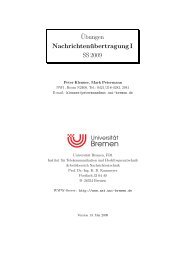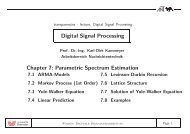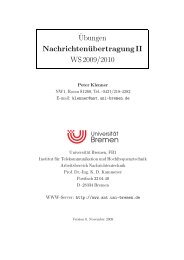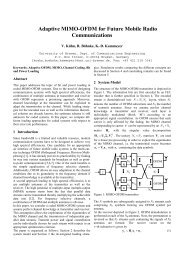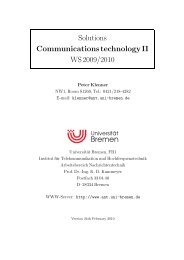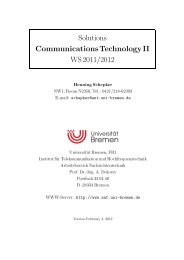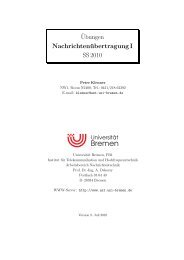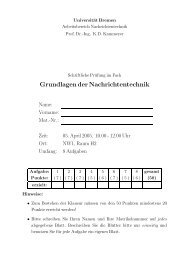Channel Coding II Exercises â SoSe 2012 â - Universität Bremen
Channel Coding II Exercises â SoSe 2012 â - Universität Bremen
Channel Coding II Exercises â SoSe 2012 â - Universität Bremen
Create successful ePaper yourself
Turn your PDF publications into a flip-book with our unique Google optimized e-Paper software.
<strong>Channel</strong> <strong>Coding</strong> <strong>II</strong><br />
<strong>Exercises</strong><br />
– <strong>SoSe</strong> <strong>2012</strong> –<br />
Dirk Wübben, Carsten Bockelmann, Matthias Woltering<br />
NW1, Raum N 2400, Tel.: 0421/218-62392<br />
E-mail: {wuebben,bockelmann,woltering}@ant.uni-bremen.de<br />
Universität <strong>Bremen</strong>, FB1<br />
Institut für Telekommunikation und Hochfrequenztechnik<br />
Arbeitsbereich Nachrichtentechnik<br />
Prof. Dr.-Ing. A. Dekorsy<br />
Postfach 33 04 40<br />
D–28334 <strong>Bremen</strong><br />
WWW-Server: http://www.ant.uni-bremen.de<br />
Version of June 20, <strong>2012</strong>
June 20, <strong>2012</strong><br />
I<br />
<strong>Exercises</strong><br />
1 Concatenated codes 1<br />
1.3 Serial concatenation of codes . . . . . . . . . . . . . . . . . . . . . . . . . . . . . . . . 1<br />
Exercise 1.1: Decoding sequence of linear product codes . . . . . . . . . . . . . . . . 1<br />
1.7 Decoding of concatenated codes . . . . . . . . . . . . . . . . . . . . . . . . . . . . . . 1<br />
Exercise 1.2: L-algebra . . . . . . . . . . . . . . . . . . . . . . . . . . . . . . . . . . 1<br />
Exercise 1.3: Comparison of the exact solution<br />
and approximation of LLR combining . . . . . . . . . . . . . . . . . . . . . . . 1<br />
Exercise 1.4: Soft-output-decoding of SPC-codes . . . . . . . . . . . . . . . . . . . . 2<br />
Exercise 1.5: BCJR Decoding of a convolutional code . . . . . . . . . . . . . . . . . . 2<br />
Exercise 1.6: Decoding of a product code . . . . . . . . . . . . . . . . . . . . . . . . 2<br />
2 Trelliscoded modulation (TCM) 3<br />
Exercise 2.1: Field of signals . . . . . . . . . . . . . . . . . . . . . . . . . . . . . . . 3<br />
Exercise 2.2: TCM-calculation . . . . . . . . . . . . . . . . . . . . . . . . . . . . . . 3<br />
Exercise 2.3: Transmission scheme . . . . . . . . . . . . . . . . . . . . . . . . . . . . 4
1 CONCATENATED CODES June 20, <strong>2012</strong> 1<br />
1 Concatenated codes<br />
1.3 Serial concatenation of codes<br />
Exercise 1.1<br />
Decoding sequence of linear product codes<br />
Considering concatenated codes as per chapter 1, the succession of the encoding and therewith of the<br />
decoding of linear constituent codes is reversible. This has the effect, that all columns and all rows<br />
represent valid code words of the respective code.<br />
Show this for linear block codes with the help of matrix calculus and check your results by means of the<br />
example given in the lecture slides (concatenation of (3,2,2)- and (4,3,2)-SPC). Note that the block<br />
interleaver has to be taken into your considerations.<br />
1.7 Decoding of concatenated codes<br />
Exercise 1.2<br />
L-algebra<br />
a) The definition of log-likelihood-ratio (LLR) is assumed to be known (see lecture slides). Prove<br />
( n∑<br />
)<br />
L ⊕u i = ln<br />
i=1<br />
n∏<br />
(e L(ui) ∏<br />
+1)+ n (e L(ui) −1)<br />
i=1<br />
i=1<br />
n∏<br />
(e L(ui) ∏<br />
+1)− n (e L(ui) −1)<br />
i=1<br />
i=1<br />
(1)<br />
by induction.<br />
b) Calculate the expected valueE{ˆx} for the estimation of a BPSK symbolxgiven the corresponding<br />
LLRL(ˆx).<br />
Plot the value E{ˆx} for different signal-to-noise-ratios by assuming the range −2 : 0.1 : 2 for the<br />
receive symbols y and the range −2 : 2 : 10 dB for E b /N 0 . Hint: For equiprobable input symbols<br />
the LLRL(ˆx) is determined by the value L(y|x) = 4α Es<br />
N 0<br />
y (we assume α = 1 in this exercise).<br />
Exercise 1.3<br />
Comparison of the exact solution<br />
and approximation of LLR combining<br />
Create a MATLAB-function [exact, approx] = llr(L), which determines the LLRs of the combination<br />
of several statistically independent values exactly (2) and approximately (3).<br />
( n<br />
)<br />
∏<br />
L(u 1 ⊕...⊕u n ) = 2artanh tanh(L(x i )/2)<br />
≈<br />
n∏<br />
i=1<br />
i=1<br />
(2)<br />
sgn(L(x i ))·min<br />
i<br />
(|L(x i )|) (3)<br />
Compare the exact solution and the approximate one with by assuming the symbols y 1 = −2 : 0.1 : 2<br />
and y 2 = 0.2 : 0.2 : 1. Determine the LLRs and plot the result against y 1 for E b /N 0 = 2dB.
1 CONCATENATED CODES June 20, <strong>2012</strong> 2<br />
Exercise 1.4<br />
Soft-output-decoding of SPC-codes<br />
a) The information word u = (1, 0, 1) is encoded with a (4,3,2)-SPC-Code, BPSK-modulated and<br />
subsequently transmitted over an AWGN-channel with a signal-to-noise ratio of E s /N 0 = 2 dB.<br />
At the receiver the sequence y = (−0.8, 1.1, 0.3, 0.4) is observed. Determine the LLRs and<br />
decode the receiving vector with the routine llr.m from exercise 1.3. What is the result<br />
b) Now decode with the approximation solution. Compare the results with a).<br />
c) Determine the probabilities for a correct decoding decision.<br />
Exercise 1.5<br />
BCJR Decoding of a convolutional code<br />
Assume, that y = [−0.6727,−0.8254,0.8133,−0.2742,0.4117,1.1832,−1.1364,−0.8861] has been<br />
received after transmission over an AWGN channel with a noise variance of σ 2 n = 1. On the transmitter<br />
side the binary information word u = [1100] has been encoded with a[5,7] 8 convolutional code, BPSK<br />
modulated (x = 1−2·c) and finally transmitted. Perform BJCR decoding under the assumption that the<br />
last state is known to be(0,0). For ease of calculation use the Max-Log-MAP in the logarithmic domain.<br />
(Hint: Draw a full trellis first, then follow: Chapter 1, CC <strong>II</strong>)<br />
Exercise 1.6<br />
Decoding of a product code<br />
Given is a product code consisting of two(3,2,2) single parity check codes. The following2×2-matrix<br />
u describes the four information bits ( ) 0 0<br />
u =<br />
0 1<br />
and the BPSK-modulated code bits are shown in the matrix x:<br />
⎛ ⎞<br />
+1 +1 +1<br />
x = ⎝ +1 −1 −1 ⎠<br />
+1 −1<br />
After transmission over an AWGN-channel with E b /N 0 = 2dB, we get the following receive matrix:<br />
⎛<br />
y = ⎝<br />
−1.5 +1.5 +1.2<br />
+1.1 +1.0 −1.5<br />
+0.5 −2.5<br />
Decode this product code step by step using MATLAB.<br />
⎞<br />
⎠
2 TRELLISCODED MODULATION (TCM) June 20, <strong>2012</strong> 3<br />
2 Trelliscoded modulation (TCM)<br />
Exercise 2.1<br />
Field of signals<br />
Given is the 8-ASK/PSK constellation in Fig. 1, that consists of two 4-PSK-constellations staggered by<br />
45 ◦ with the radii r and 2r.<br />
x 5<br />
2r<br />
x<br />
x0<br />
1<br />
r<br />
45°<br />
x 4<br />
x 6<br />
x x<br />
2<br />
3<br />
x 7<br />
Fig. 1: Field of signals of the 8-ASK-PSK constellation<br />
a) Determine the minimal Euclidean distance ∆ 0 for E S = 1.<br />
b) Determine the asymptotic coding gain compared with an 8-PSK and a 2-PSK.<br />
Exercise 2.2<br />
TCM-calculation<br />
Given is the represented convolutional encoder with the code rate R = K/(K + 1) = 1/2 and the<br />
memory m = 2, that shall be used for TCM together with aq = 2 M+1 = 8-ary ASK-constellation.<br />
u i (2)<br />
c i (2)<br />
+<br />
c i (1)<br />
x(i)<br />
8-ASK <br />
u i (1)<br />
D<br />
D<br />
c i (0)<br />
Fig. 2: Field of code words ford min = 8<br />
a) Determine the corresponding partitioning of the field of signals for 8-ASK.<br />
b) Determine the corresponding Trellis segment.<br />
c) Determine the asymptotic coding gain compared with a 4-ASK.<br />
Exercise 2.3<br />
Transmission scheme
2 TRELLISCODED MODULATION (TCM) June 20, <strong>2012</strong> 4<br />
Write a simulation program for a 8-PSK transmission. Construct the transmitter (source, modulator), the<br />
channel (AWGN) and the receiver (demodulator, decision).<br />
Subsequently determine the bit error rate and the symbol error rate in dependence onE b /N 0 andE s /N 0 .



